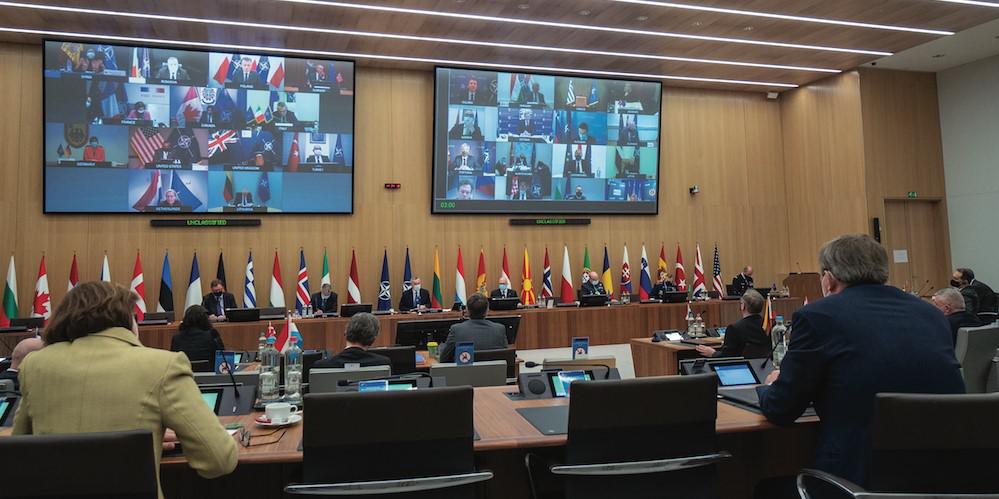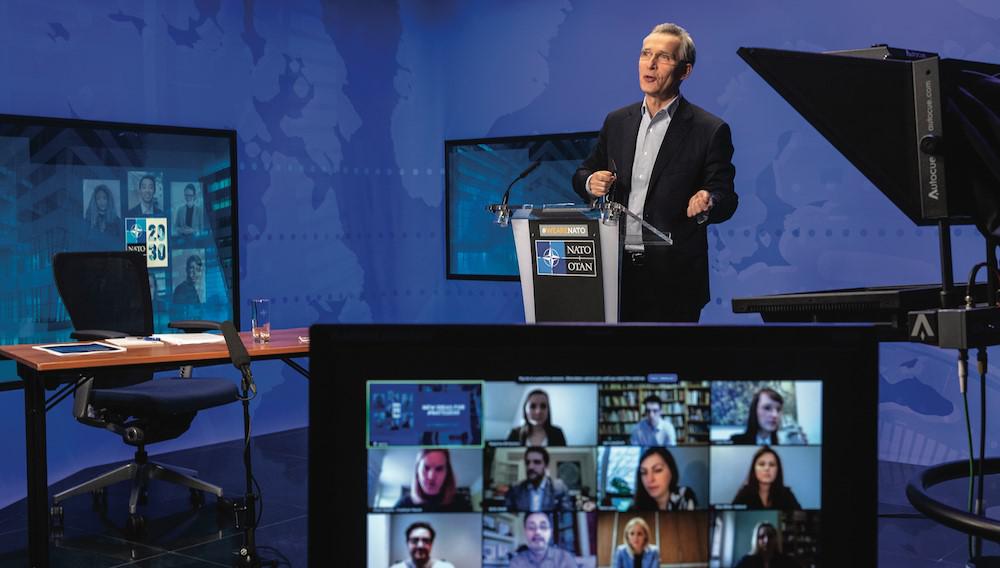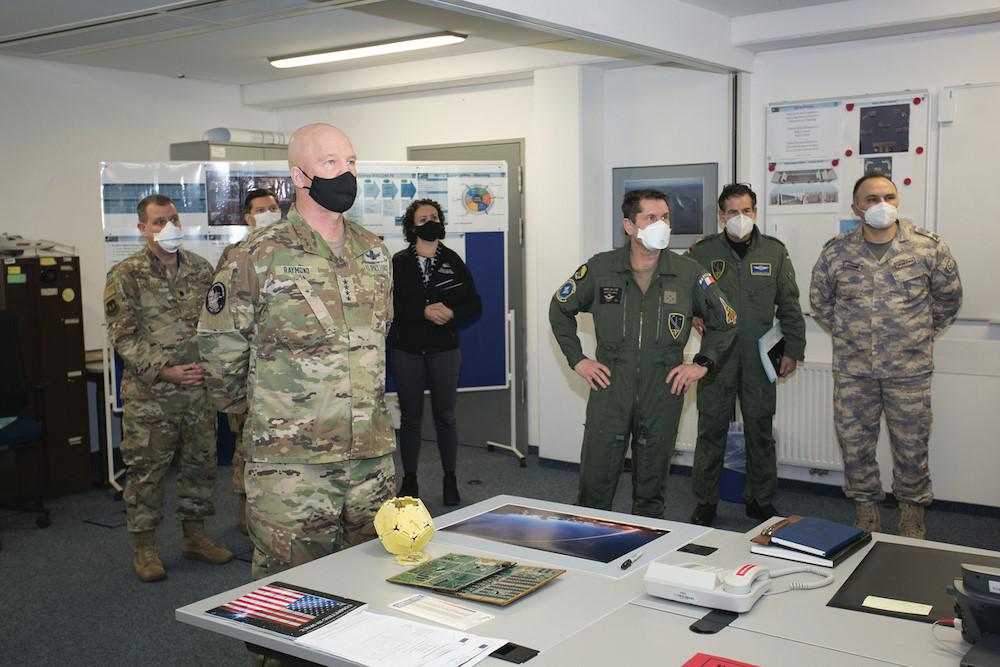Up-Tempo Technology Progress Shifts Power Balance
NATO is at risk of losing its technology edge because of emerging and disruptive technologies increasingly developed within the civil sector. The growth of peer competitors’ determination, especially China, and the decline of technology education in Western countries are eroding the advantage they once skillfully held.
To address this state of affairs, the organization’s defense ministers are examining a number of activities. As a part of this initiative, the NATO Industrial Advisory Group (NIAG) conducted a study to provide the industry view of the implications of emerging and disruptive technologies (EDTs) and Chinese advances in defense operations and military capability development.
The increasingly rapid rate of technological change combined with the drivers and sourcing of the technology progressively coming from the civil sector will profoundly affect the defense capabilities, military operations and future structure of the defense industry.
NIAG’s study examined NATO’s Science and Technology Trends Report and confirmed, from an industrial perspective, its findings. However, a fuller analysis of EDT implications must take into account that each technology analyzed does not provide a capability itself. Instead, it is the combination of technologies that is likely to enhance Western alliance defense capabilities or, when deployed by an adversary, pose threats.
Common to all of the technologies is a reliance on the supply of computer processing chips. This presents a particular vulnerability for China. The country can’t currently satisfy all of its technological needs and, therefore, still relies on significant access to Western technology and products.
In the artificial intelligence (AI), machine learning (ML) and big data domains, NATO and its allies lead the research and development effort in many AI fields, such as cloud computing and data cubes. However, the Western alliance nations must not become complacent about this status. Instead, they must continue to invest in all aspects of AI and ML research and development as China is investing heavily in these areas.
Concerning big data and big data analytics, China plans to match the West’s capabilities within the next few years and then assume the dominant position. Its development of probabilistic computer chips has enabled the country to demonstrate an advanced capability in neuromorphic computing technology, which it uses in unmanned systems.
In addition to these innovations, cybersecurity continues to be a top priority. It is a key feature during all phases of data utilization, including collection, analysis, distribution and archiving. Moving forward, information security, as well as independence from foreign technologies and improved knowledge sharing among Western allies, should become major objectives for NATO.
China has commercial capabilities for systems with autonomous functions similar to those currently used and traded globally. The country is actively pursuing AI-enabled systems and autonomous capabilities as part of its military modernization program. The People’s Liberation Army (PLA) is paying special attention to military robotics and unmanned ground systems that can be used for logistics support.
The PLA Navy reportedly is developing autonomous surface and subsurface vessels. The cultural differences of a potential adversary may mean that the consequences in managing any collateral damage may not be of much importance, which could give an adversary the operational edge when using autonomous capabilities.
The use of truly unmanned systems, particularly those that can produce lethal effects, presents Western allies with a dilemma in ethical, legal and safety concerns. Consequently, these nations must urgently address these issues to benefit from the operational potential that autonomous systems offer. However, there would still be a need to invest in countermeasures should an adversary decide to deploy this type of capability.
The opinion is divided as to whether China leads the technological race to produce and exploit 5G by facilitating other technologies such as AI, particularly given the recent U.S. trade sanctions on the export of computer chips to China. However, China is a significant player in the development of standards for 5G and was a major contributor to the national deployment of 5G infrastructure in South Korea, which now claims to lead the world in the use of this technology.
In the West, telecommunications regulators are still auctioning spectrum for the higher frequency 5G services, so 5G service penetration on the scale of South Korea is some way off.
However, China recently appears to be starting to develop and test next-generation 6G bearer technologies. More generally, new cellular technologies are causing competition for and congestion of a spectrum that disadvantage the military and broader public sector.
In the quantum technology domain, while the United States is considered the leader in the commercial development, the Chinese are investing heavily in defense applications of quantum technology. China is assessed as well ahead of NATO nations in quantum communications and has achieved significant advances in the quantum sensing domain.
Quantum crypto offers the Chinese a high-integrity crypto key management and distribution capability to support military operations at long distances from national borders. A high sensitivity quantum-based navigation system could enhance the concealment of Chinese strategic subsurface assets. Some reports indicate the Chinese development of a superconductive magnetic anomaly detector array, using quantum sensing technology, significantly enhances the PLA’s antisubmarine warfare capabilities.
In terms of intellectual property rights, the study found that China has frequently infringed on these, but change is occurring. Now, China holds numerous patents and is taking the lead in developing international standards and heading international engineering institutions such as the International Telecommunications Union. It is positioning itself to become one of the world’s most innovative nations in this area by 2030 and aims to be a self-sufficient science and technology superpower by 2049.
The change of status from poacher to gamekeeper is funded by China’s position as the second-largest economy in the world. Part of this wealth and innovation is being applied to its military power.
The study indicates it is time—perhaps overdue—to assess how these changes affect NATO. China has stated an intent to surpass U.S. AI capabilities by 2030. Its disciplined and systematic approach to technological development, coupled with its underlying focused and deliberate ideology, could mean the West’s current leading position in many technological domains will diminish rapidly.
In some specific areas, China has already assumed this leading role, the study found. For example, the Western allies’ traditional lead in technology use for defense purposes, when compared against peer nations and other adversaries, is now being challenged by the rapid development and application of EDT in the defense domain. While Russia has probably made the most significant advances in developments in the hypersonic, ballistic missile and anti-satellite domains, the study found, it is the Chinese who pose the more serious threat across a much wider spectrum of defense capabilities.
This has serious implications for Western allies, and urgent action is necessary to reverse this trend. Where this is not possible or practicable, countermeasures must be developed to mitigate any threats, study participants recommend. However, they point out that verification of any claims concerning technological advances in the defense domain from open-source material is always challenging, even when comparing the data to some of NATO’s peer nation adversaries.
In terms of human resources, China is well-positioned with a large, highly educated, skilled and extremely motivated workforce. The country invests heavily in education, and the largest percentage of foreign students studying at universities around the world are Chinese, which provides the nation with valuable insight into international commercial and technical issues.
A recent article in the UK newspaper The Times reports that registrations of Chinese nationals at UK universities have increased year on year. For the 2020 academic year, for example, a 23 percent increase had been recorded. In terms of the highest number of international students registered in the UK, China leads the list with 12,100 students, with India in second place with just 3,110 student registrations. Of particular interest is that China has an increasing number of students studying science and technology, which gives it visibility of the research and development procedures and processes being used internationally, enabling China to apply—or copy—the best-in-class techniques and procedures into their own research and development efforts.
In the longer term, the education and skills balance is likely to swing toward China’s favor because, based on a Programme for International Student Assessment 2018 assessment by the Organisation for Economic Cooperation and Development (OECD), NATO and its allies are clearly losing superiority in mathematics and science education. The assessment indicated that 15-year-old students in the four provinces/municipalities of China that participated in the study—Beijing, Shanghai, Jiangsu and Zhejiang—outperformed their peers from all of the other 78 participating education systems by a large margin in both mathematics and science.
Even in reading, 10 percent of the most disadvantaged students in these four jurisdictions showed better skills than those of the average student in the other countries the OECD assessed, which include those in NATO nations. While these four provinces/municipalities in eastern China are far from representing the country as a whole, the population of each of them compares to that of a typical country that was measured, and their combined populations amount to more than 180 million.
Conversely, the decline in the number of students entering science and technical education in NATO and Western allies is likely to result in shortages not only in science and technology human resources and skills but also in industrial productivity and technical support staff. Western alliance nations must encourage more students to enter the science and technology specializations so a sufficiently trained and qualified workforce is available in the future to stimulate innovation. This action will ensure the necessary capabilities that Western allies have indigenous abilities to maintain the defense capability edge against peer adversaries.
Miroslav Nečas is a business development manager at TOVEK, responsible for research projects, product development and methodology. He is a member of the of AFCEA Czech Chapter board of directors.








Comments